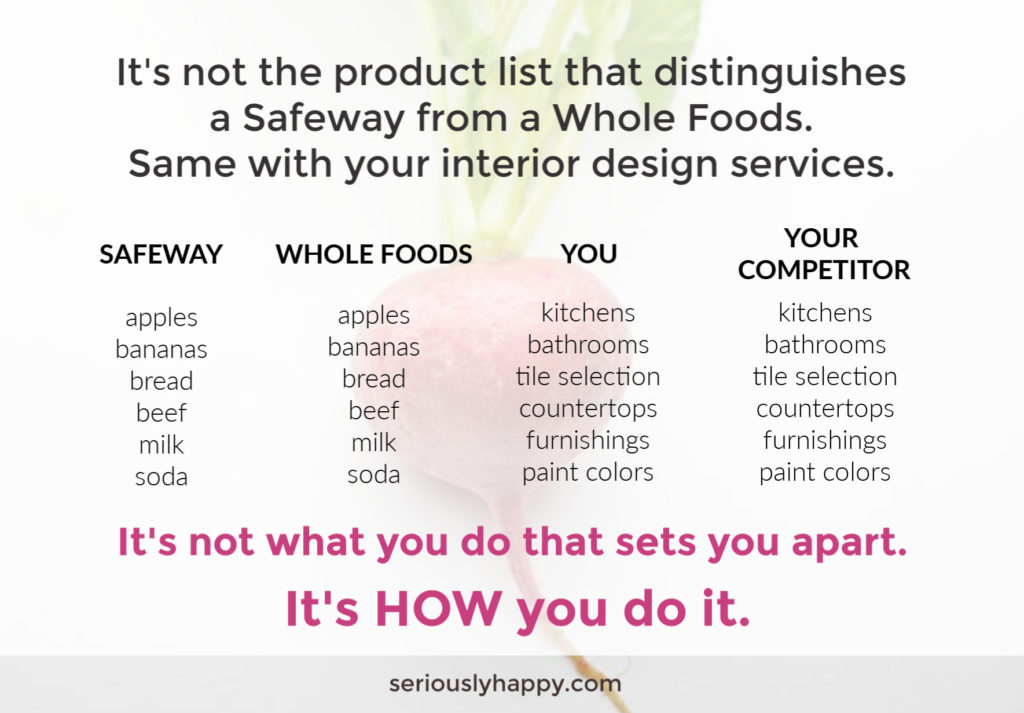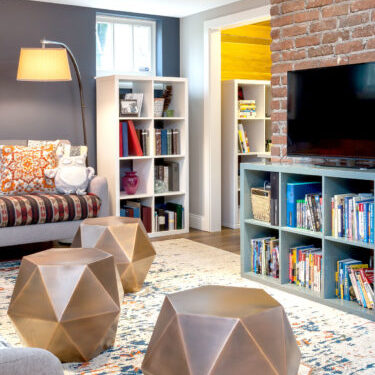When talking about what we should charge for our interior design services, people often say to research the market and find out what other folks are charging for their services. While it is certainly essential to understand the market so you aren’t unintentionally priced way higher or lower than your colleagues, it’s just as important to make sure you are comparing apples to apples.
Here are three questions to ask when figuring out what to charge for your interior design work:
- What is the going rate for interior design services in my area? Do I want to be perceived as more affordable and accessible than, in-line with, or more luxury and exclusive than my colleagues?
- What can I charge based on my personal sense of self-worth and experience level? Do I have what it takes to express myself confidently when saying my price to my clients?
- What – exactly – is the service I am providing compared to my colleagues, and what should I charge for it?
What’s the going rate?
The first question – what is the going rate – just takes research. Ask around, research your colleagues’ websites, ask on interior design forums, google it… some people even pretend to be a prospective client and call around.
How much do I believe in my value?
The second question is a matter of personal self-confidence and practice. Money and value are mental games, and so much of it comes down to whether or not you believe what you are saying. Just like people follow leaders who speak with confidence, people pay service providers who speak with confidence. So pick a number and practice saying it out loud enough times that you don’t stumble, blush, or lose eye contact with the person you are talking to. Try “kitchen designs average $8500 each” or “My hourly rate is $425” and see how it feels. Make the number big enough to be uncomfortable, so that when you are in front of a customer saying “My hourly rate is $225” it’ll feel affordable. Practice! I promise you’ll get better at it!
What am I actually providing?
The third question is where many interior designers fall short – they never think through their services. They just create a laundry list of things they can help with: curtains, kitchen remodels, furniture selection, tile, paint colors, light fixtures…. But that is like a grocery store listing the produce they sell: zucchini, bananas, kale, kumquats, apples, carrots, arugula… If that was how services worked, then an apple at Whole Foods wouldn’t cost 3 times as much as at Safeway.
So, are you the Whole Foods, or the Safeway, of interior design?
What is the quality of your produce? The selection and variety? Do you source speciality, hard to find produce? Do you offer local farm-to-table organic veggies? Or do you provide affordable produce for the masses? Beyond that, are you just offering a pick-your-own produce display, or are you also offering pre-sliced veggies and ready-made, take-away gourmet salads? Do you offer home-delivery for your groceries?
Now, I know you are not a grocery store, but it’s the same in interior design. What is your service level?
Are you offering a simple selection service? “I’ll pick your paint colors, finishes and fixtures, and then you (client) are free to purchase them on your own.”
Are you offering a complete design service? “I’ll measure your space, layout your kitchen or living room, and then shop the items for a completely executable design you can execute on your own.”
Or are you offering a full service, white glove, project management or GC service? “From dirt to coasters, I’ll measure, layout, and design your space, and then oversee ordering and install from start to finish.”
Maybe you offer all three, but they are spelled out a different service offerings (and price points).

Beyond the service level, what is your customization level?
Do you shop retail – the Pottery Barns and Wayfairs of the world?
Or do you shop fully custom, to-the-trade only sources with a focus on eco-friendly, or locally made, or internationally sources, or handmade goods?
The more custom, the more cost – because it literally takes longer to source more custom and more specialty items.
If you are offering flat-rate services, then your actual service should be spelled out clearly and your rate should reflect it. If you are offering selections only, shopped retail, perhaps that is a $500 service. If you are designing the same room with full installations, perhaps that is a $15000 service. Spelling out your service and considering the amount of time that will be needed to provide that service at the level you expect your company to provide your clients will help you not only set your price, but be able to share it confidently – because you now understand the value of your service.
If you are offering hourly-services, then you still want to go through the exercise of understanding if what the client is asking for is likely to result in a $500 bill or a $15,000 bill – if they think what you are providing will be $500, you’re going to have a heck of a time sending out and collecting on those invoices as they go up and up and up.
I often recommend a flat-fee structure, but it’s not for everyone – check out my post on whether a flat fee or hourly rate is the right choice for you here.
The point is that what you charge should be based in part on
- The going rate in your market and
- Your personal confidence and experience level, but should be heavily determined by
- The service you are providing to your customers. And if you can’t define that service, you aren’t ready to set your price.
Want to get an outside eye on your current service offerings? That is a great use of my Quick Fix service – let’s spend a happy hour together reviewing your current services and I’ll give you my honest appraisal and guidance on how to make your offerings clearer, more appealing, and more exclusive. What to dig in and really define and hone those services? That’s a perfect fit my Accelerator program – three months to figure out what part of your market you want to claim, and set yourself apart from your colleagues! I’m here if you need help!
May your business always make you Seriously Happy!

Hi! I’m Rebecca!
When I closed my design biz to move to Paris I discovered how hard it was for me to refer my clients to other designers because I couldn't tell what the designer did, who they did it for, or what they delivered!
Now I'm on a mission to help designers nail their niche and set clear client expectations.
It's all about being able to clearly communicate what you do, who you do it for, what they should expect, and what they'll get, and it's the #1 key to getting hired by clients you love to work on projects you're proud of!

